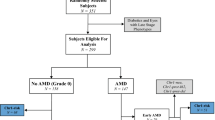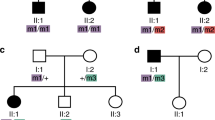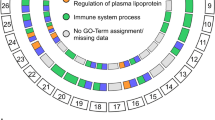Abstract
In developed countries, age-related macular degeneration is a common cause of blindness in the elderly. A common polymorphism, encoding the sequence variation Y402H in complement factor H (CFH), has been strongly associated with disease susceptibility. Here, we examined 84 polymorphisms in and around CFH in 726 affected individuals (including 544 unrelated individuals) and 268 unrelated controls. In this sample, 20 of these polymorphisms showed stronger association with disease susceptibility than the Y402H variant. Further, no single polymorphism could account for the contribution of the CFH locus to disease susceptibility. Instead, multiple polymorphisms defined a set of four common haplotypes (of which two were associated with disease susceptibility and two seemed to be protective) and multiple rare haplotypes (associated with increased susceptibility in aggregate). Our results suggest that there are multiple disease susceptibility alleles in the region and that noncoding CFH variants play a role in disease susceptibility.
This is a preview of subscription content, access via your institution
Access options
Subscribe to this journal
Receive 12 print issues and online access
$209.00 per year
only $17.42 per issue
Buy this article
- Purchase on Springer Link
- Instant access to full article PDF
Prices may be subject to local taxes which are calculated during checkout

Similar content being viewed by others
References
Majewski, J. et al. Age-related macular degeneration–a genome scan in extended families. Am. J. Hum. Genet. 73, 540–550 (2003).
Abecasis, G.R. et al. Age-related macular degeneration: a high-resolution genome scan for susceptibility loci in a population enriched for late-stage disease. Am. J. Hum. Genet. 74, 482–494 (2004).
Weeks, D.E. et al. Age-related maculopathy: an expanded genome-wide scan with evidence of susceptibility loci within the 1q31 and 17q25 regions. Am. J. Ophthalmol. 132, 682–692 (2001).
Seddon, J.M., Santangelo, S.L., Book, K., Chong, S. & Cote, J. A genomewide scan for age-related macular degeneration provides evidence for linkage to several chromosomal regions. Am. J. Hum. Genet. 73, 780–790 (2003).
Fisher, S.A. et al. Meta-analysis of genome scans of age-related macular degeneration. Hum. Mol. Genet. 14, 2257–2264 (2005).
Hirvela, H., Luukinen, H., Laara, E., Sc, L. & Laatikainen, L. Risk factors of age-related maculopathy in a population 70 years of age or older. Ophthalmology 103, 871–877 (1996).
Smith, W. et al. Risk factors for age-related macular degeneration: Pooled findings from three continents. Ophthalmology 108, 697–704 (2001).
Klein, R., Klein, B.E., Tomany, S.C. & Moss, S.E. Ten-year incidence of age-related maculopathy and smoking and drinking: the Beaver Dam Eye Study. Am. J. Epidemiol. 156, 589–598 (2002).
Schmidt, S. et al. Cigarette smoking strongly modifies the association of LOC387715 and age-related macular degeneration. Am. J. Hum. Genet. 78, 852–864 (2006).
Klein, R.J. et al. Complement factor H polymorphism in age-related macular degeneration. Science 308, 385–389 (2005).
Haines, J.L. et al. Complement factor H variant increases the risk of age-related macular degeneration. Science 308, 419–421 (2005).
Edwards, A.O. et al. Complement factor H polymorphism and age-related macular degeneration. Science 308, 421–424 (2005).
Jakobsdottir, J. et al. Susceptibility genes for age-related maculopathy on chromosome 10q26. Am. J. Hum. Genet. 77, 389–407 (2005).
Rivera, A. et al. Hypothetical LOC387715 is a second major susceptibility gene for age-related macular degeneration, contributing independently of complement factor H to disease risk. Hum. Mol. Genet. 14, 3227–3236 (2005).
Zareparsi, S. et al. Strong association of the Y402H variant in complement factor H at 1q32 with susceptibility to age-related macular degeneration. Am. J. Hum. Genet. 77, 149–153 (2005).
Li, M., Boehnke, M. & Abecasis, G.R. Joint modeling of linkage and association: identifying SNPs responsible for a linkage signal. Am. J. Hum. Genet. 76, 934–949 (2005).
Li, M., Boehnke, M. & Abecasis, G.R. Efficient study designs for test of genetic association using sibship data and unrelated cases and controls. Am. J. Hum. Genet. 78, 778–792 (2006).
Risch, N. Linkage strategies for genetically complex traits. I. Multilocus models. Am. J. Hum. Genet. 46, 222–228 (1990).
Hodge, S.E. & Elston, R.C. Lods, wrods, and mods: the interpretation of lod scores calculated under different models. Genet. Epidemiol. 11, 329–342 (1994).
Valdes, A.M. & Thomson, G. Detecting disease-predisposing variants: the haplotype method. Am. J. Hum. Genet. 60, 703–716 (1997).
Zaykin, D.V. et al. Testing association of statistically inferred haplotypes with discrete and continuous traits in samples of unrelated individuals. Hum. Hered. 53, 79–91 (2002).
Stephens, M., Smith, N.J. & Donnelly, P. A new statistical method for haplotype reconstruction from population data. Am. J. Hum. Genet. 68, 978–989 (2001).
Li, N. & Stephens, M. Modeling linkage disequilibrium and identifying recombination hotspots using single-nucleotide polymorphism data. Genetics 165, 2213–2233 (2003).
The International HapMap Consortium. The International HapMap Project. Nature 437, 1299–1320 (2005).
Monks, S.A. et al. Genetic inheritance of gene expression in human cell lines. Am. J. Hum. Genet. 75, 1094–1105 (2004).
Bird, A.C. et al. An international classification and grading system for age-related maculopathy and age-related macular degeneration. The International ARM Epidemiological Study Group. Surv. Ophthalmol. 39, 367–374 (1995).
Wigginton, J.E., Cutler, D.J. & Abecasis, G.R. A note on exact tests of Hardy-Weinberg equilibrium. Am. J. Hum. Genet. 76, 887–883 (2005).
Abecasis, G.R., Martin, R. & Lewitzky, S. Estimation of haplotype frequencies from diploid data. Am. J. Hum. Genet. 69, S198 (2001).
Abecasis, G.R. & Cookson, W.O.C. GOLD—graphical overview of linkage disequilibrium. Bioinformatics 16, 182–183 (2000).
Stephens, M. & Scheet, P. Accounting for decay of linkage disequilibrium in haplotype inference and missing-data imputation. Am. J. Hum. Genet. 76, 449–462 (2005).
Acknowledgements
We acknowledge the participation of members of AMD-affected families and of numerous clinicians and clinical staff members, without whose generous assistance and dedication this work would not be possible. We also thank M. Boehnke and R. Spielman for comments on early versions of the manuscript, S. Gabriel and L. Ziagra at the Broad Institute/National Center for Research Resources Genotyping Center for generating the genotype data and for stimulating discussions, R. Lyons at the University of Michigan Sequencing facility for help with DNA sequencing and S. Ferrara for administrative support. This research was supported by grants from the US National Institutes of Health, The Foundation Fighting Blindness, the Elmer and Sylvia Sramek Foundation and Research to Prevent Blindness (RPB). A.S. is Harold F. Falls Collegiate Professor and a recipient of an RPB Senior Scientific Investigator award. G.R.A. is a Pew Scholar for the Biomedical Sciences. P.A.-S. was supported in part by a scholarship from TUBITAK.
Author information
Authors and Affiliations
Contributions
M.L., Y.L. and L.L. carried out the statistical analyses. P.A.-S., M.O., K.E.H.-B., R.K.M.S.W. and S.Z. were responsible for execution of experiments and for sample preparation and collection. A.S. and G.R.A. conceived and directed the study.
Corresponding authors
Supplementary information
Supplementary Fig. 1
Analysis of Y402H and of SNPs selected in our stepwise search using the haplotype method of Valdes and Thomson (1997). (PDF 430 kb)
Supplementary Fig. 2
Sensitivity of LAMP results to estimates of disease prevalence. (PDF 80 kb)
Supplementary Table 1
Association test results for all SNPs. (PDF 112 kb)
Supplementary Table 2
Genotype counts and allelic and genotypic association test results for all 84 SNPs. (PDF 21 kb)
Supplementary Table 3
Genotype counts and mean allelic and genotypic test results in the 10 imputed datasets. (PDF 19 kb)
Supplementary Table 4
Results using alternative approaches for SNP selection. (PDF 11 kb)
Supplementary Table 5
Results of exhaustive search for the best SNP combination. (PDF 12 kb)
Supplementary Table 6
Haplo-genotype counts for cases and controls. (PDF 11 kb)
Rights and permissions
About this article
Cite this article
Li, M., Atmaca-Sonmez, P., Othman, M. et al. CFH haplotypes without the Y402H coding variant show strong association with susceptibility to age-related macular degeneration. Nat Genet 38, 1049–1054 (2006). https://doi.org/10.1038/ng1871
Received:
Accepted:
Published:
Issue Date:
DOI: https://doi.org/10.1038/ng1871
This article is cited by
-
Levels of complement factor H-related 4 protein do not influence susceptibility to age-related macular degeneration or its course of progression
Nature Communications (2024)
-
The application and progression of CRISPR/Cas9 technology in ophthalmological diseases
Eye (2023)
-
Polygenic risk score and biochemical/environmental variables predict a low-risk profile of age-related macular degeneration in Sardinia
Graefe's Archive for Clinical and Experimental Ophthalmology (2023)
-
Future perspectives for treating patients with geographic atrophy
Graefe's Archive for Clinical and Experimental Ophthalmology (2023)
-
Complement Mediators in Development to Treat Age-Related Macular Degeneration
Drugs & Aging (2022)



